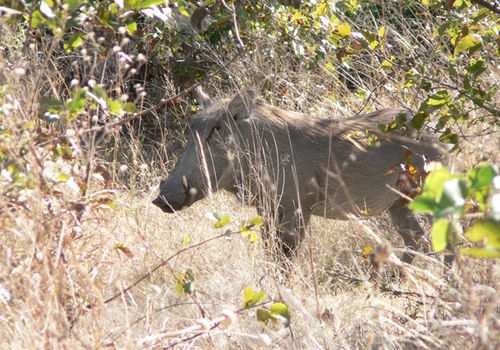
Warthog
Phacochoreus aethiopicusWarthog
Introduction: The warthog is an African pig with large curved tusks protruding from its huge flattened head, one set from both upper and lower jaws. It gets it name from the gristly warts that protrude from the sides of its face. Boars have two pairs, sows only on. It is not known for certain what purpose the warts serve. One explanation is that they are used as a weapon, or, alternatively, as a defence in fending off blows from other warthogs.
Warthogs live in families of related females with their offspring and ten individuals may form a sounder. They travel in small family groups and are a common sight in Namibia, often seen wandering along the side of the highway. They act as as nature's gardeners and till large areas of soil through their digging exploits. Apart from aerating the soil and softening it to allow the rain to sink in, they also bury and thus protect seeds from fire damage, whilst at the same time they expose other bulbs to which birds such as the francolin are partial. They are great mud wallowers.
Distribution: Warthogs can be seen all over central Namibia and are often found grazing on the verges of the road. For those arriving in the country, they can often be seen on the short trip from the International Airport into Windhoek. Care should be taken while driving as warthogs can do considerable damage to vehicles and passengers.
Diet: In general, warthogs are mainly vegetarians, living on annual and perennial short grasses, but also roots, fruit and even carrion. They are not dependent on the availability of water, but will drink it regularly if there is a supply.
Colouring: Grey and both sexes have a crest of long black, brown or yellowish bristly hair from between the ears to the base of the tail, which normally hangs down over the sides of the shoulders and body, but can be erect under stress.
Breeding: Females give birth to litters of 2 to 5, in burrows, using original aardvark excavations. They are born from around September to December - after a gestation period of just more than 5 months.
Size: The shoulder height is up to 70cm and they weigh between 60 and 100kg. Females stand 60cm and a mass of up to 60kg. Their tusks may be as much as 61cm long.
Klein Windhoek

